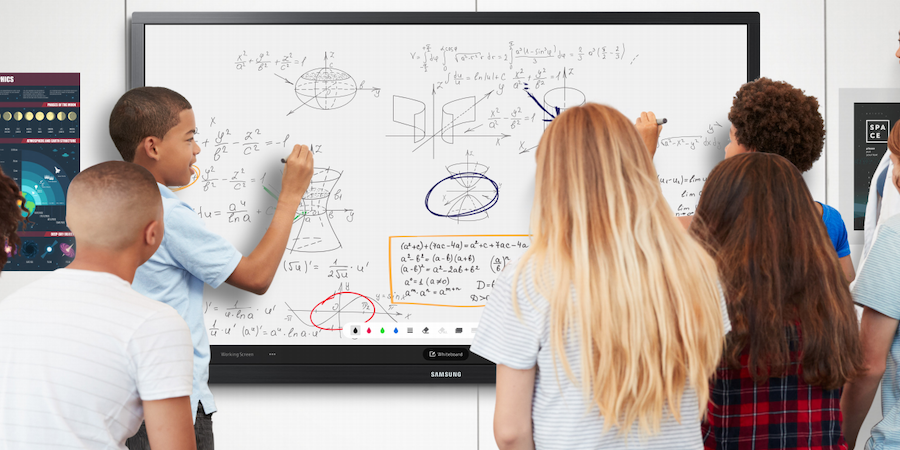Artificial intelligence (AI) is already impacting every area of life and culture — including education. For many teachers, this can create a sense of anxiety. Emerging technologies such as generative AI (GenAI) are fast-moving and unpredictable. “There’s a lot of nervousness about what it means and how to utilize it,” explained Dee Lanier, educational technology consultant for Samsung. “Right now, educators have more questions than answers.”
Blocking AI from school systems might feel like the safest approach right now, but it’s important to realize that the technology is here to stay. Furthermore, students need to be prepared for a world where AI is part of the landscape. And many teachers — 62%, according to a recent EdWeek survey — want to learn how to teach students to use it responsibly and effectively.
Narratives about AI in K-12 education
Two narratives dominate right now around AI in education: One celebrates the potential to automate monotonous tasks for teachers, such as grading homework and creating assessments. The other expresses concern about what access to GenAI means for students who use it to write essays and complete assignments. Let’s take a closer look at both issues.
- Empowering teachers. Unfortunately, many teachers are saddled with menial tasks such as paperwork and data entry, draining their energy and keeping them from teaching the way they want to teach. To those nearing burnout, AI’s potential to save time and simplify tedious work is highly promising. School administrators should provide training and guidance, so teachers can learn how to harness GenAI to optimize their efficiency. Some free resources to check out include Code.org’s online course, AI 101 for Teachers and Artificial Intelligence (AI) Education for Teachers from Macquarie University.
- Guiding students. While schools are eager to help teachers harness AI, they might be less thrilled to see students use it, especially to produce their homework and essays. “I look at that dichotomy as a power dynamic,” said Lanier. “You’re going to empower teachers to utilize these tools well and then restrict power for students to use it for cheating.” While some restrictions may be necessary, especially in the early days, schools should take a more open approach to student use of AI. Schools can give both guidance and guardrails for students and teachers, encouraging them to learn together. “They can be in conversation together as they explore these tools and establish rules about their ethical use in the classroom. These students will grow in their digital citizenship and awareness — and build skills that are necessary for the future.”
Make learning more fun with interactive technology
Learn why interactive learning matters and how prioritizing it engages students and improves outcomes.
Download Now
Considerations for AI adoption
How can AI help teachers in the classroom? GenAI is a disruptive technology with the potential to change the way teachers teach and students learn. Anytime an innovative shift of this magnitude occurs, there’s an adjustment period — and a learning curve.
As school leaders recognize the permanence of AI and its ubiquitous availability, they must think about ways to embrace the technology and manage its use, while contemplating its shortcomings. Here are some considerations to keep in mind as you build a strategy for AI in education:
- Prepare students to compete in an AI-saturated world. If your students graduate with no exposure to AI tools, they will have a hard time competing with graduates from other school systems that embraced AI and prepared their students to use it well. If they are up against someone else who’s able to wield it effectively, they may be at a significant disadvantage.
- Consider potential value contrasts and biases. Most AI tools are developed by corporations, whose bottom line is financial profit — an important value contrast to keep in mind when you’re choosing to use AI in the education setting. Bias is another issue to consider. GenAI tools rely on algorithms, which are based on human-developed data sets. And those humans, like all humans, have biases. This means it’s important to identify bias when it appears in AI output, while at the same time recognizing your own. “How effective are we at identifying bias in general in our own life and decisions?” he said. “You can’t identify something if that is not a personal practice as well. We have to build skills to see the AI biases as reflective of the involvement of other humans. It’s really about gaining those skills personally and then applying them to digital outputs as well.”
- Encourage experimentation. There’s no one right answer to the question, “Which AI tool is best for education?” Instead, try different tools and see how they work for different tasks. ChatGPT is known for its creative capacities, for example, while Gemini and Claude are better at retrieving current data from the web. Rapid uptake and integration of AI also means new tools will become available quickly, so be sure to experiment with those, too.
Incorporating GenAI in the classroom
We are in learning mode when it comes to the use of AI in schools. It’s important to consider the ways in which AI can add value and not replace key learnings. A smart method is jumping in with students to experiment together. Use your Samsung Interactive Display to pull up Microsoft Copilot and show students that it’s actually a free version of ChatGPT 4. Then, open other AI tools, such as Gemini and Claude, and experiment with prompts. Use the note tool to annotate and highlight differences between results. After you gather and compare data, practice crafting prompts until you get the results you’re after. “Learning to create effective prompts is a little like learning to code,” said Lanier. “Students and teachers need to understand the language that works best, and variables they can adjust to create different outcomes.”
Educator Paul Ketko offers several free resources for learning to write effective GenAI prompts. Also, check out AI for Education’s free presentation Prompt Engineering for Educators. Otherwise, experimentation is a great way to learn. Let students work in groups and report on what they discover. Then, start creating community rules about how AI can be used for student work. Talk through the ethical questions and find solutions. “It becomes an interactive conversation as you learn about these tools,” Lanier said. “Students see, hey, we’re going to do this together.”
Learn more about how simple, scalable and secure display solutions empower educators to take control of the curriculum in this free guide. And discover the full range of Samsung Interactive Displays, all designed for more engaging and visually enhanced collaboration.











